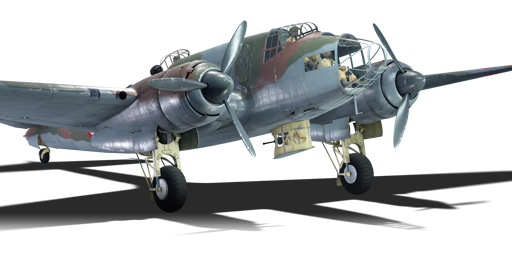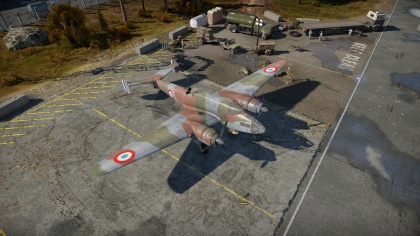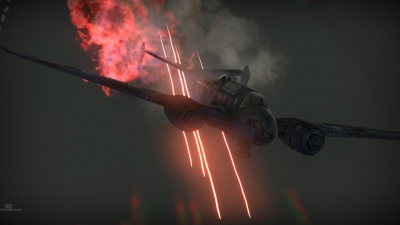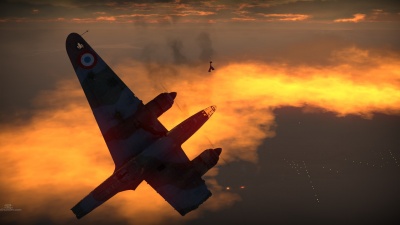LeO 451 early
Contents
| This page is about the French medium bomber LeO 451 early. For other version, see LeO 451 late. |
Description
The LeO 451 early is a rank II French medium bomber
with a battle rating of 3.0 (AB/RB/SB). It was introduced in Update 1.73 "Vive la France".
The LeO 451 is a versatile high-speed medium bomber that is capable of undertaking low-level ground attack strikes against tanks, pillboxes, and other small targets. It also carries a fairly respectable bomb load for its battle rating, and can be used to destroy bases efficiently. The sleek, graceful lines of the LeO 451 represent a complete departure from the very angular, slab-sided Farman F.222.2 and SNCAC NC.223.3 heavy bombers. The LeO 451 sacrifices bombload for high speed, although at a 1,900 kg maximum load it still carries a respectable amount compared to similar bombers like the Petlyakov Pe-2 and the CRDA Cant.Z.1007bis Alcione series. It is also quite manoeuvrable for a twin-engine bomber.
General info
Flight performance
Describe how the aircraft behaves in the air. Speed, manoeuvrability, acceleration and allowable loads - these are the most important characteristics of the vehicle.
| Characteristics | Max Speed (km/h at 6,250 m) |
Max altitude (meters) |
Turn time (seconds) |
Rate of climb (meters/second) |
Take-off run (meters) | |||
|---|---|---|---|---|---|---|---|---|
| AB | RB | AB | RB | AB | RB | |||
| Stock | 471 | 456 | 10500 | 31.3 | 32.2 | 3.3 | 550 | |
| Upgraded | 522 | 495 | 28.8 | 30.0 | 9.7 | 5.9 | ||
Details
| Features | |||||
|---|---|---|---|---|---|
| Combat flaps | Take-off flaps | Landing flaps | Air brakes | Arrestor gear | |
| ✓ | ✓ | ✓ | X | X | |
| Limits | ||||||
|---|---|---|---|---|---|---|
| Wings (km/h) | Gear (km/h) | Flaps (km/h) | Max Static G | |||
| Combat | Take-off | Landing | + | - | ||
| 550 | 340 | 400 | ___ | 270 | ~6 | ~4 |
| Optimal velocities (km/h) | |||
|---|---|---|---|
| Ailerons | Rudder | Elevators | Radiator |
| < 315 | < 310 | < 350 | > 340 |
| Compressor | Optimal altitude | 100% Engine power | WEP Engine power |
|---|---|---|---|
| Setting 1 | 3,900 m | 1,070 hp | 1,372 hp |
Survivability and armour
- 12 mm steel plate behind the pilot
- 12 mm steel plate in front of dorsal gunner
- Self-sealing fuel tanks (2 in each wing)
Armaments
Offensive armament
The LeO 451 early is armed with:
- 1 x 7.5 mm MAC 1934 machine gun, nose-mounted (1,500 rpg)
Suspended armament
The LeO 451 early can be outfitted with the following ordnance:
- 16 x 50 kg G.A. MMN. 50 bombs (800 kg total)
- 7 x 100 kg No.1 bombs (700 kg total)
- 6 x 200 kg No.1 bombs + 1 x 100 kg No.1 bomb (1,300 kg total)
- 2 x 500 kg No.2 bombs + 4 x 200 kg No.1 bombs + 1 x 100 kg No.1 bomb (1,900 kg total)
Defensive armament
The LeO 451 early is defended by:
- 1 x 20 mm Hispano 404 cannon, dorsal turret (120 rpg)
- 1 x 7.5 mm MAC 1934 machine gun, ventral turret (500 rpg)
Usage in battles
The LeO 451 can operate as a low-level attacker with relatively decent chances of survival thanks to the 20 mm dorsal gun and its relatively high performance. Flying at low altitudes also prevents enemies from attacking it from the rear and below, which is only covered by the 7.5 mm ventral gondola machine gun.
If pursued, it is best to manoeuvre in such a way that the enemy is forced to attack from the rear, which is covered by the 20 mm cannon. The LeO 451 is otherwise very vulnerable to attacks from any other angle.
Defensive armament is concentrated against rear attackers, featuring a powerful Hispano HS.404 cannon in the dorsal gunner position, with a relatively ineffective 7.5 mm machine gun in the ventral gondola. The historical LeO 451 could retract this gondola to reduce drag; a feature that is sadly not represented in the game, as the lower drag would probably be more useful than the machine gun. The LeO 451 otherwise has no other defensive armament besides a fixed forward-firing 7.5 mm machine gun in the nose. This machine gun is useful for strafing soft targets like vehicles and artillery or taking potshots at aircraft but is generally not very useful otherwise.
Manual Engine Control
| MEC elements | ||||||
|---|---|---|---|---|---|---|
| Mixer | Pitch | Radiator | Supercharger | Turbocharger | ||
| Oil | Water | Type | ||||
| Controllable | Controllable Not auto controlled |
Controllable Not auto controlled |
Controllable Not auto controlled |
Separate | Not controllable 1 gear |
Not controllable |
Modules
| Tier | Flight performance | Survivability | Weaponry | |||
|---|---|---|---|---|---|---|
| I | Fuselage repair | Radiator | Offensive 7 mm | Turret 20 mm | 100 GPs | |
| II | Compressor | Airframe | New 7 mm MGs | 200 GPs | ||
| III | Wings repair | Engine | Turret 7 mm | New 20 mm cannons (turret) | 500 GPs | |
| IV | Engine injection | Cover | New 7 mm MGs (turret) | |||
Pros and cons
Pros:
- Decent maximum bombload (2 x 500 kg, 4 x 200 kg, 1 x 100 kg for 1,900 kg total)
- Powerful dorsal turret with 20 mm cannon
- Relatively fast and manoeuvrable for a bomber
- Fixed 7.5 mm nose machine gun for strafing ground targets or attacking aircraft
Cons:
- Very limited defensive gun arcs: only the rear is covered
- Can only rely on the fixed 7.5 mm machine gun to defend against frontal attacks
- Ventral gunner is not protected by armour and easily knocked out
- Ventral turret armed with only one 7.5 mm machine gun
History
Development of the LeO 451 began in the early 1930s, after the newly formed Armée de l'air issued the so called Plan I, intended to increase the number of modern military aircraft available to the French Air Force. As part of this plan, the young Air Force was keen on expanding and developing their strategic bombing branch. However, as the already available bombers, such as the Farman F.221, were considered unsuitable for the needs of the Air Force, a set of specifications was issued for the development of a brand new bomber. Among other aircraft manufacturers, Lioré et Olivier (which would be nationalized as part of SNCASE) also submitted their LeO 45 design. Being a long-time supplier to the French Air Force, Lioré et Olivier had a reputation of building reliable and effective bombers dating back to WW1. Thanks to this, the further development of the LeO 45 was approved. The first prototype (LeO 45-01), powered by a pair of Hispano-Suiza engines, took flight on 16 January 1937. Despite showing some minor issues, the LeO 45 prototype displayed excellent performance. A second prototype, equipped with a pair of Gnome-Rhone engines was also constructed and subsequently designated LeO 451-01. Testing of the 451 prototype began in October 1938.
However, due to various production issues associated with the Gnome-Rhone engine, production of the LeO 451 was delayed, beginning only in late 1938. Although the Armée de l'air only fielded a handful of operational LeO 451 bombers at the outbreak of WW2, their number would rise up prior to the Invasion of France in May 1940. During this chapter of WW2, the LeO 451 saw wide use against both advancing German forces on the east and Italian forces on the south. While the aircraft suffered great losses at the hands of Luftwaffe’s superior fighters and the Wehrmacht’s relentless anti-air guns, it fared a lot better on the southern front against Italian forces. Nonetheless, the LeO 451 did eventually retire in September 1957 as the final pre-war French aircraft to leave active duty.
- From Devblog
Media
Excellent additions to the article would be video guides, screenshots from the game, and photos.
See also
Links to the articles on the War Thunder Wiki that you think will be useful for the reader, for example:
- reference to the series of the aircraft;
- links to approximate analogues of other nations and research trees.
External links
| Lioré et Olivier (SNCASE) | |
|---|---|
| Bombers | LeO 451 early · LeO 451 late |
| France bombers | |
|---|---|
| Farman | F.222.2 · N.C.223.3 |
| Latécoère | Late 298D |
| Potez | Potez 633 |
| Liore et Olivier | LeO 451 early · LeO 451 late |
| Bloch | M.B.174A-3 · M.B.162 · M.B.175T |
| American | V-156-F · Martin 167-A3 · ▄A-35B · ▄SB2C-5 · B-26C · ▄PBY-5A Late · ▄PB4Y-2 |
| British | Lancaster MR.7 |







